
“When he came on board as union secretary, Richard transformed the scattershot nature of our messaging into a consistent, coherent, and effective communications strategy, both internal and external. Two highlights: the monthly “Frank Talk” column he ghostwrote for me and the way he used our blog to educate, unify, and (when necessary) mobilize our membership. His ability to think strategically when it came to communications definitely helped us be more effective as a union.”
—Frank Frisenda, former President of the Nassau Community College Federation of Teachers
My Business Writing Story
Before I began working for my union as their communications coordinator, I had a consulting business on the side called Writing the Future of Your Business. I wrote and ghostwrote copy for businesses in a wide range of industries, including hospitality, travel, freight auditing, web marketing, healthcare, productivity/professional organizing, and accounting and finance. My tag line was “Because people will see, in the care you take with your words, the care you will take with the business they give you”—a little long, I know, but it's true. Words, especially in the digital age, are often all you have to make a first impression, whether those words are printed on paper, published on a digital device, or spoken in a promotional video. Most of the worked I was hired to do back then was business-to-business, but I had some business-to-consumer clients as well. I wrote direct mail postcards, pitch letters, brochure and/or website copy, and monthly columns in industry publications, among other documents. I even edited a medicare guide for an HMO.
When I began to work for my union, and especially once I was elected secretary, I brought what I'd learned about business communication to bear on the union's lack of a coherent communications strategy, both internal and external. I overhauled the way we used our blog so it became a communications channel read by both our membership and the college administration; ghostwrote a monthly column for the union president both to keep our membership informed and to mobilize them when necessary; wrote the script for a Facebook and YouTube video introducing us to the surrounding community; and designed and implemented a "Know Your Contract" educational campaign. Most recently, I brought that same kind of strategic thinking to a monthly bulletin I’ve been hired to ghostwrite for a college president looking to overhaul how their administration communicates with the campus they are charged with running.
If you’re looking for someone who understands, and knows how to implement, big-picture thinking when it comes to communication, while at the same time possessing the writing and editorial skills to make sure the texts you need to produce are compelling and pristine, take a look at the three case studies I’ve provided below. If you think I might be a good fit, let’s talk.
Case Studies
Seriatim: Naming A Business
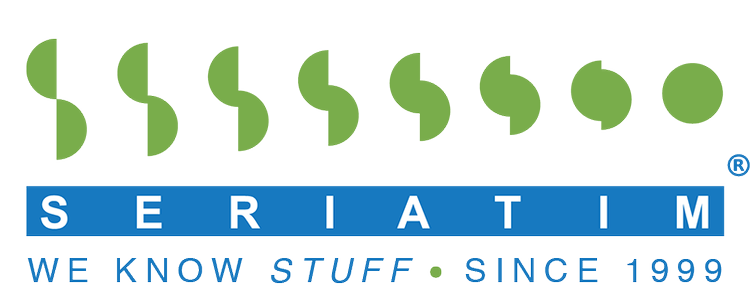
The principle embodied by my old business tag line—Because people will see, in the care you take with your words, the care you will take with the business they give you—applies most obviously to the different genres of business communication: emails, proposals, memos, texts, social media posts, and marketing literature. It also applies, though, to your company’s name. Whether you choose a one-word name, invent a word to be the name, or use a phrase, like the name I gave to my business, you want what you call your business to encapsulate the story you have to tell, allowing the value of what you have to offer to speak for itself.
I met Sonya Weishappel, founder and CEO of Seriatim, a professional organizer and inventory management business, in the late 1990s, when we were both members of a networking group called LeTip. Sonya was getting ready to launch her business, but had not yet named it. She hired me to help her do that, giving me these four straightforward guidelines:
- The name should be a single word.
- It should have nothing to do with her name.
- It should describe a process.
- It should have intellectual gravitas.
At its most basic level, to organize is to bring order to disorder, but that definition says nothing about the organizing process itself. I’m a bit of a grammar nerd, so I thought immediately of looking for either an adjective or an adverb to name Sonya’s business, since those are the parts of speech that modify nouns (organizer, organization) and verbs (to organize) respectively. Search engines were not back then what they are today, so I sat at my desk taking notes as I paged through a pile of reference books, among them The Compact Edition of The Oxford English Dictionary, a volume called The Disheveled Dictionary: A Curious Caper Through Our Sumptuous Lexicon, and The Encyclopedia of Word and Phrase Origins.
The initial list of possibilities covered an entire page. As I whittled them down, though, the word seriatim stood out as the obvious choice, meeting of all of Sonya's criteria
- It was a single word that had nothing to do with her name.
- Its Latinate form had the intellectual gravitas she was looking for.
- It can be used as either an adverb or an adjective, though the former is more common, to describe a process in which each item or subject is dealt with in order, one at a time—precisely the way you would want a professional organizer to work.
- Plus, as an added bonus, seriatim flows easily and rhythmically off the tongue.
Sonya launched Seriatim in 1999, and the company is now in its twenty-sixth year of providing the highest quality service to its clients. That service, of course, is the beating heart of her company’s success, but the story that informs Seriatim’s commitment to service is rooted in no small measure in the company’s name and the care and precision with which Sonya insisted it be chosen.
The Nassau Community College Federation of Teachers: Building A Communications Strategy
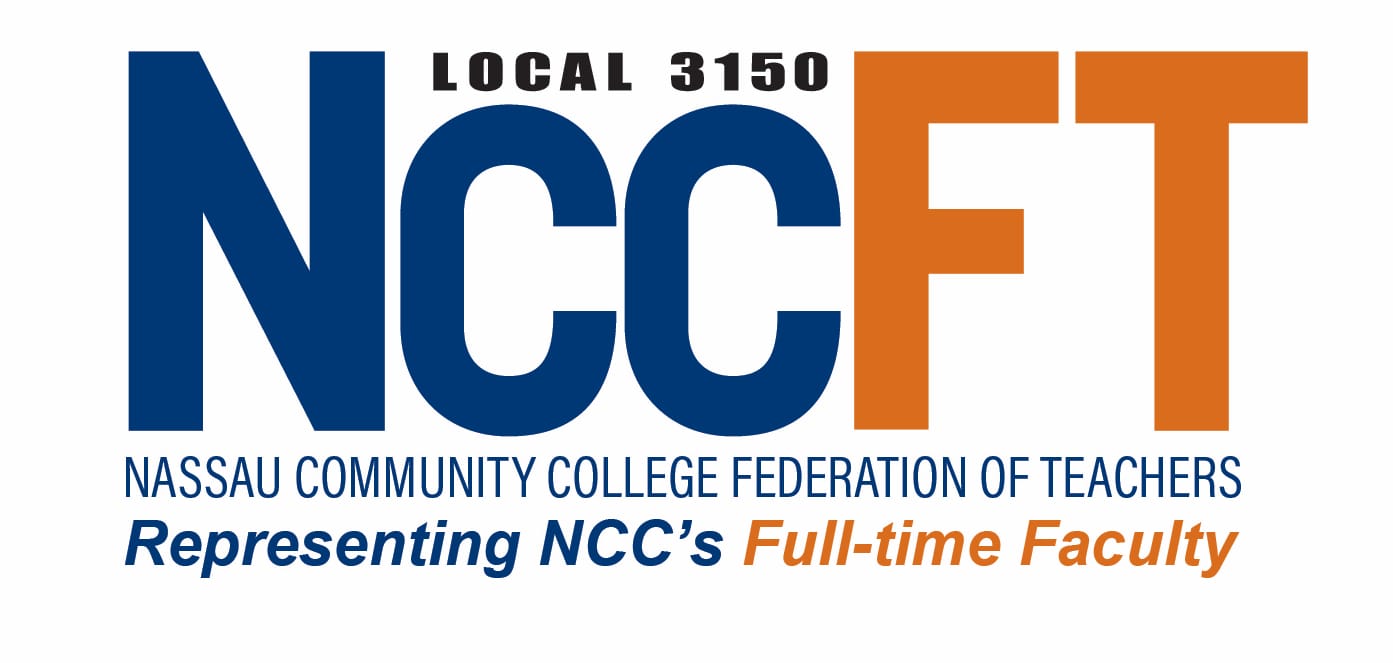
When I was elected secretary of my faculty union in 2016, the biggest challenge I faced was our lack of a communications strategy with clearly defined internal and external goals and objectives. Internally, we needed to communicate in ways that engendered solidarity and, when necessary, inspired mobilization. Externally, we needed to do two things:
- Introduce ourselves to the community we served as a union of higher education professionals
- Publicly hold the college administration to account when we disagreed with them and offer them support when that was the right thing for us to do
To accomplish these goals, I instituted a three-pronged strategy to help us get the word out about who we were and why we mattered:
- A monthly column from the union president on our blog
- An internal, “Know Your Contract” education campaign
- Community outreach on social media
§§§
Prong One: Frank Talk From The President’s Desk
At least a decade before I was elected, our membership voted to discontinue the union’s hard copy, monthly newsletter in favor of a website and a blog. The goal was admirable, to save paper, but because no one had fully thought through what it would mean to move the newsletter's functions over to the blog, ending the newsletter also meant the end of the monthly column the union president had been publishing to that point. That column had been both his or her primary channel of communication with the membership and a kind of secondary channel to the administration, since we knew they "listened in" on our business by reading the newsletter. One of the first things I did as secretary, therefore, was persuade our president, whose name happened to be Frank that he should reintroduce the practice of speaking to the membership in this way. He agreed, and I ghostwrote “Frank Talk From The President’s Desk” for him from 2016 until he retired in 2020.
We used Frank Talk in several different ways, ranging from a simple “Welcome Back” message at the beginning of each semester to far more serious matters, like communicating what the impact of the Supreme Court's Janus decision was likely to be and keeping the membership informed about COVID-related issues.
- You can read the column about Janus here.
- You can read two examples of the COVID updates here and here.
“Frank Talk From The President’s Desk” became the hub around which much of the rest of what I posted on the blog was built. So, for example, following up on the Janus column I linked to above, I wrote a five piece series (1, 2, 3, 4, 5) to educate our members on what the Janus case was about and why it was so important to maintain solidarity in the face of the danger it posed. I also instituted a regular “Asked & Answered” blog post, in which the executive committee responded to questions put to us by the membership. An example of this kind of post, responding to a question about a COVID-related ventilation study that our college administration commissioned, can be found here.
§§§
Prong Two: Know Your Contract
The core mission of any union is to negotiate and protect the contract its members have with their employer. A contract, however, does far more than stipulate the salary and benefits with which union members are paid for their labor. In setting out the terms and conditions of that employment, a contract also defines an employee’s relationship with:
- The job they’ve been hired to do
- Their colleagues
- Their employer
- The life they live outside their identity as an employee
One challenge faced by the executive committee on which I served was the prevailing sense of complacency we saw among our members when it came to the contract. Most, but especially our newer members, had not been around when the original contract was negotiated and so they had no idea how hard the union had fought for much that they took for granted. In response, I designed a “Know Your Contract” campaign. The campaign had two components: a series of six broadsides, each one addressing a different component of the contract, and a series of discussion-starting contractual scenarios—all based on real-life examples from the past—that we presented to our executive board, asking them to bring that discussion back to their departments, along with the broadsides.
On one side of the broadside was a graphic I designed to illustrate just how complex and comprehensive the contract was:
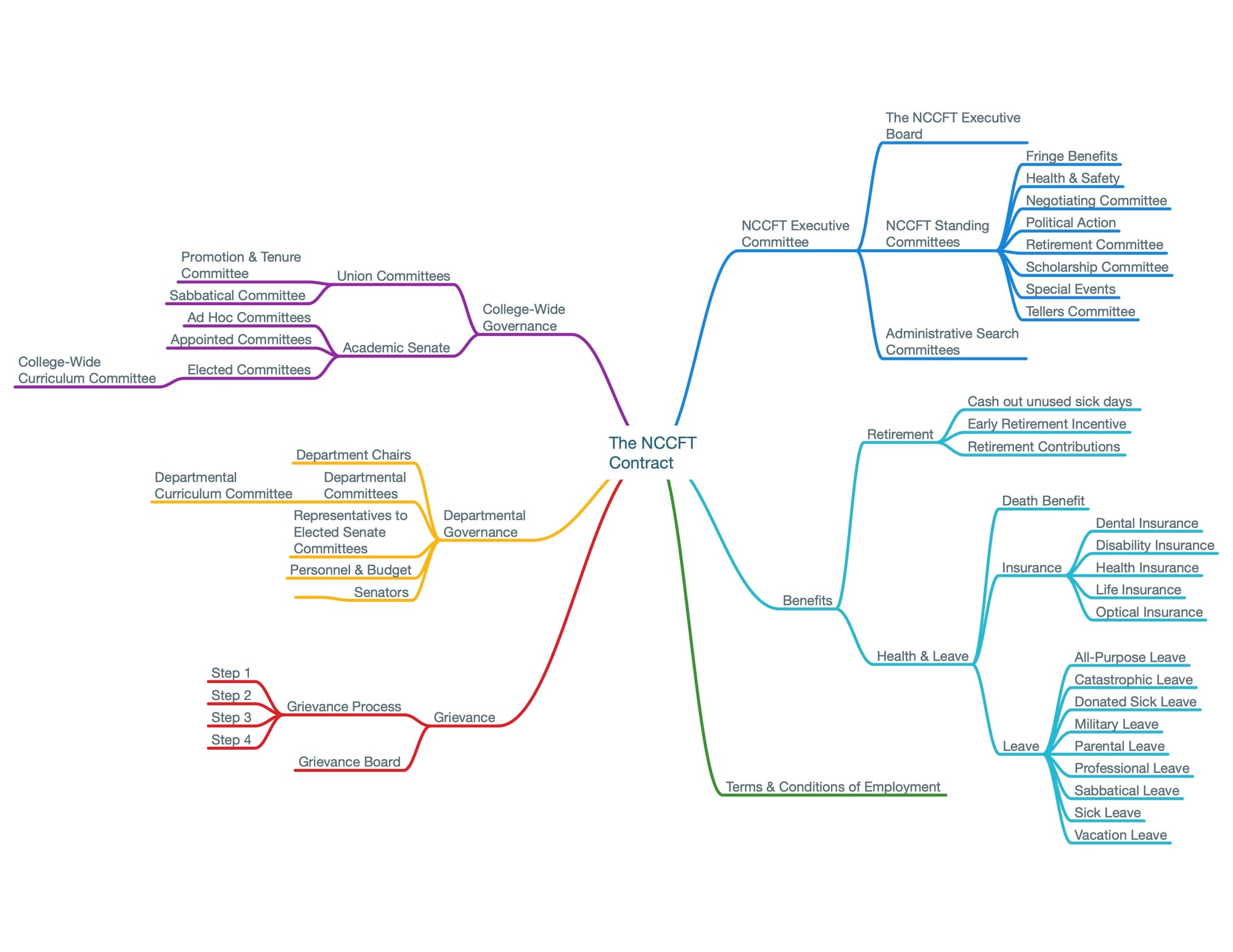
Perhaps the most nuanced component of any educational campaign like this, though, is figuring out how to meet your audience where they are, while also pushing them to move a little further in the direction you want them to go. In this case, that meant appealing to our members' self-interest, both individual and collective. On the other side of each broadside, therefore, was a brief narrative about one component of the contract, written to explain very clearly why it should matter to them. We began with the one called "Terms and Conditions of Employment."
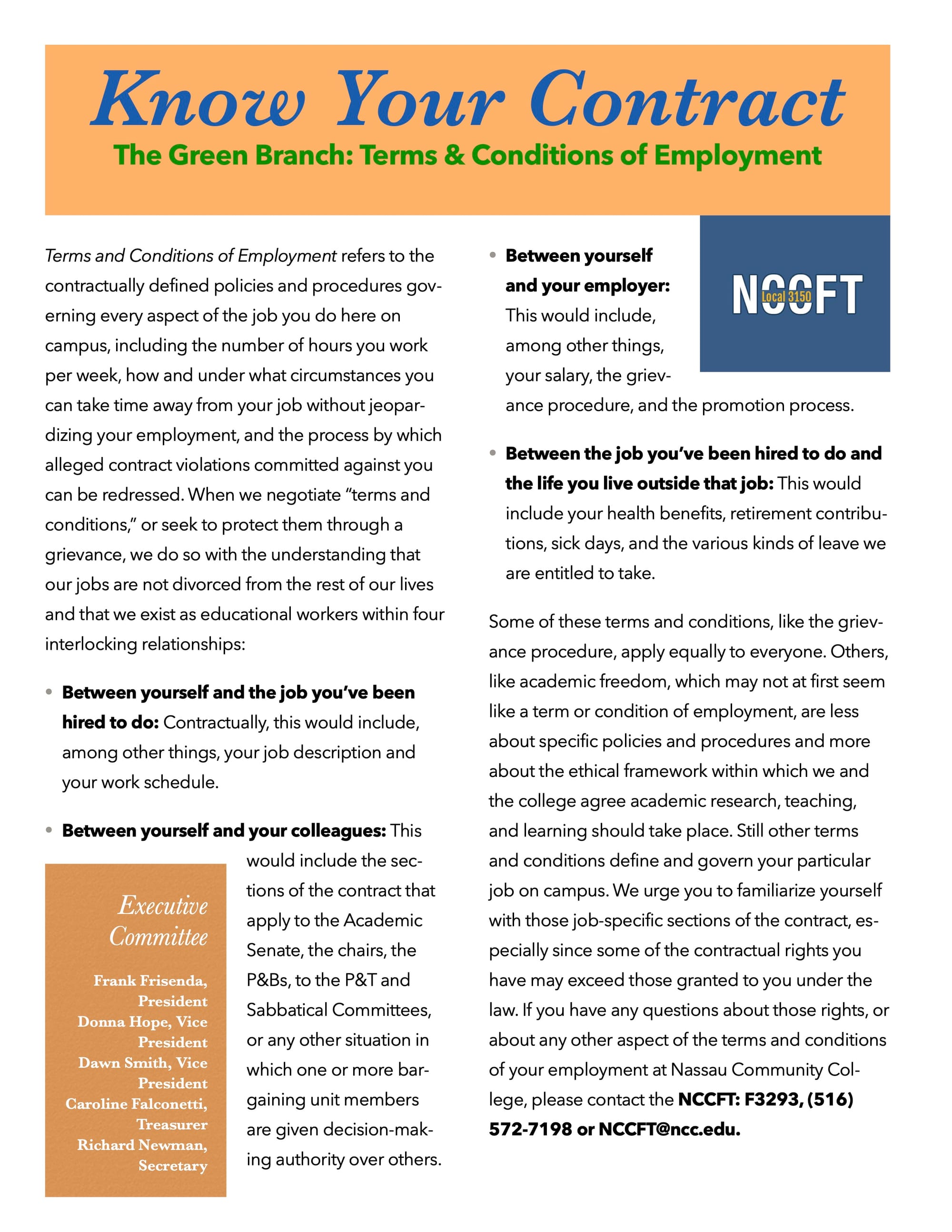
If you would like to read the other broadsides, I've collected them in this file:
§§§
Prong 3: Consider This An Invitation
As a union of higher education professionals, the Nassau Community College Federation of Teachers commits itself to serve the educational needs of our students and of their communities. That part of our identity, however, rarely got the kind of public attention it deserved. So we decided to take action on our own behalf, producing this video, the script for which I wrote, and promoting it on YouTube and Facebook.
The Roslyn Bread Company
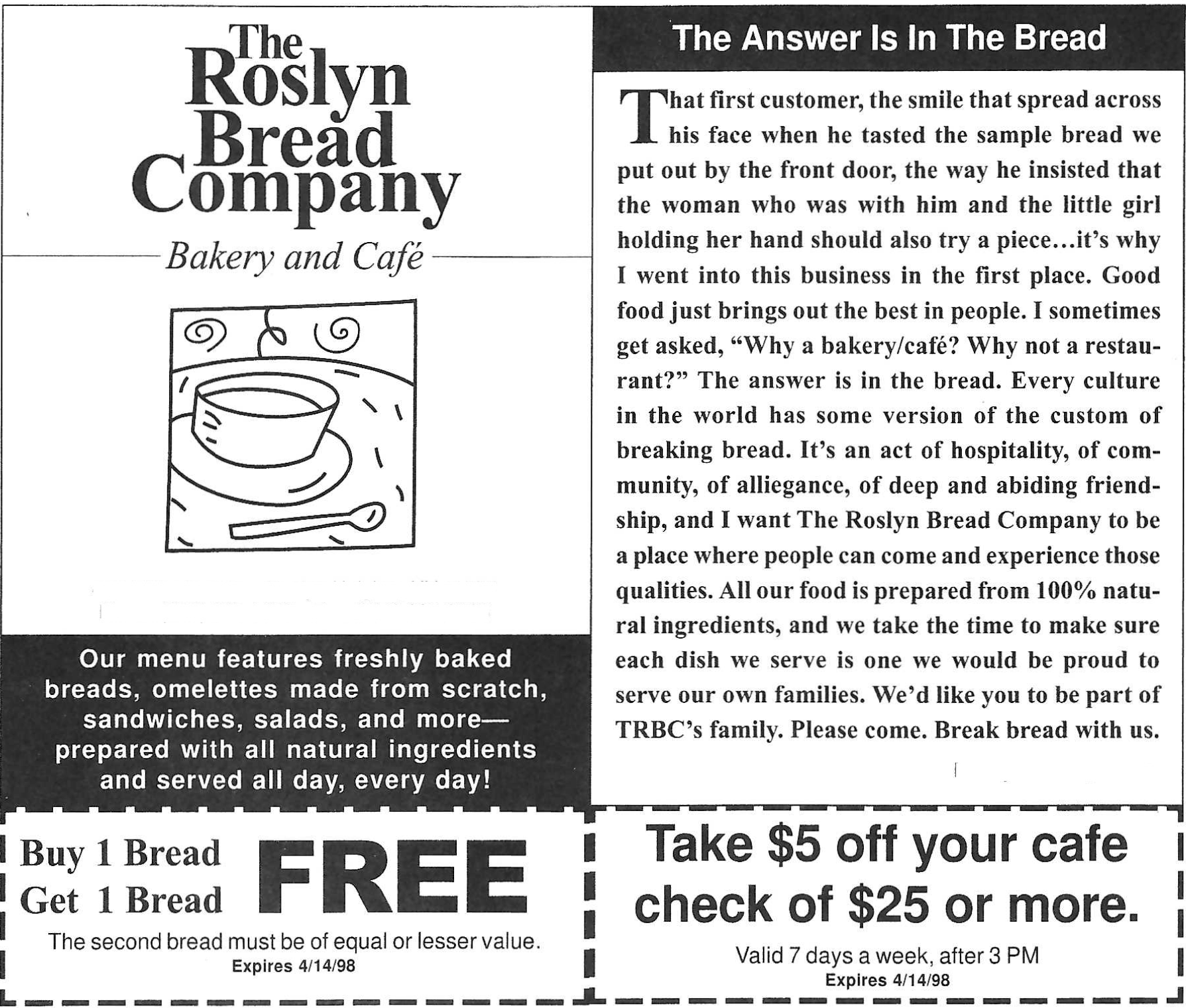
When I met with the owner of the newly-opened The Roslyn Bread Company, she was looking for a way to promote her bakery-café rooted in the idea of the neighborhood “joint” that she wanted it to become. We hit on the idea of a series of coupons, each of which would also include a chapter in the unfolding narrative, told in the owner’s voice, of the people who became her customers. The plan was—in addition to whatever kind of local distribution the owner could arrange—to have the coupons spread around the establishment so that whether people came in to sit at a table or just pick something up at the counter, they would be able to read the next chapter in the story. The example you see above was a mock-up of the first coupon. We were in the process of deciding how the man, the woman, and the girl would be related; what their names were; what their purchases would be; and so on, when a fire in one of the ovens damaged the building severely enough that it put the bakery out of business. Thankfully, as I remember it, no one was hurt, and the owner, those whom she employed, and I moved on. I have always wondered, though, how the story we were preparing to tell would have unfolded and what impact it would have had on her business.